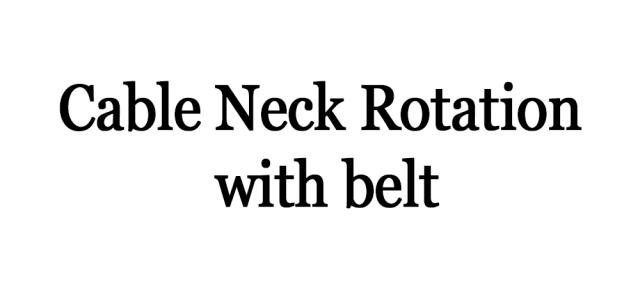Table of Contents
Cable Neck Rotation with belt is a variation of the standard Cable Neck Rotation exercise. This variation involves using a belt or strap to provide additional resistance and support during the exercise. By attaching the belt to the cable machine and securing it around the forehead or back of the head, you can increase the intensity of the exercise and target the muscles of the neck more effectively. In this comprehensive guide, we’ll explore the correct technique, benefits, variations, and other essential details associated with Cable Neck Rotation with belt.
Instructions for Cable Neck Rotation with belt
Setup:
- Adjust the Cable Machine: Attach a belt or strap to the lowest setting on the cable machine. Ensure that the weight stack is set at an appropriate resistance level.
- Position Yourself: Stand perpendicular to the cable machine with your feet shoulder-width apart and knees slightly bent. Adjust the distance from the machine to ensure there is tension on the belt when your head is in a neutral position.
Execution:
- Starting Position: Stand tall with your spine in a neutral position and your shoulders relaxed. Hold onto the cable machine handle with both hands, keeping your arms extended in front of you.
- Neck Rotation: Inhale and slowly rotate your neck to one side, bringing your chin over your shoulder. Keep your movements slow and controlled, focusing on engaging the muscles of the neck.
- Peak Contraction: Once you reach the end of the range of motion, pause briefly to squeeze the muscles on the side of your neck. Focus on maintaining tension in the muscles throughout the contraction.
- Return to Starting Position: Exhale as you slowly rotate your neck back to the starting position, resisting the pull of the cable. Maintain control over the movement to prevent jerking or sudden movements.
- Repeat on the Other Side: Perform the same movement on the opposite side, rotating your neck to the other side to complete one repetition.
Benefits
- Increased Resistance: Using a belt or strap adds resistance to the Cable Neck Rotation exercise, making it more challenging and effective for strengthening the muscles of the neck.
- Improved Muscle Engagement: The added resistance helps to increase muscle activation in the neck muscles, leading to greater strength gains and muscle development.
- Enhanced Range of Motion: Cable Neck Rotation with a belt allows for a greater range of motion compared to traditional neck rotation exercises, helping to improve flexibility and mobility in the neck.
- Variety: Cable Neck Rotation with a belt offers a variation to standard neck rotation exercises, helping to prevent plateaus and keep workouts interesting.
Muscles worked in Cable Neck Rotation with belt
Cable Neck Rotation with belt primarily targets the muscles of the neck, including the sternocleidomastoid (SCM), scalene muscles, and deep cervical muscles. Here’s a breakdown of the main muscles worked during this exercise:
- Sternocleidomastoid (SCM): The SCM is a large muscle located on each side of the neck. It originates from the sternum and clavicle and inserted into the mastoid process of the temporal bone. Contraction of the SCM muscle causes neck rotation to the opposite side.
- Scalene Muscles: The scalene muscles are a group of three muscles (anterior, middle, and posterior) located on each side of the neck. They originate from the cervical vertebrae and are inserted into the first and second ribs. Contraction of the scalene muscles assists in neck rotation and lateral flexion of the neck.
- Deep Cervical Muscles: These muscles, including the longus colli and longus capitis, are deep muscles located on the front of the neck. They play a role in stabilizing and supporting the cervical spine during movement.
- Other Neck Muscles: Various other muscles of the neck, including the levator scapulae, splenius capitis, and splenius cervicis, may also be engaged to a lesser extent during Cable Neck Rotation with a belt.
By performing Cable Neck Rotation with belt, you can effectively target and strengthen these muscles, improving neck mobility, stability, and overall functional strength. It’s essential to maintain proper form and control throughout the exercise to maximize its effectiveness and minimize the risk of injury. Additionally, start with lighter weights and gradually increase the resistance as you become more comfortable with the movement. If you experience any discomfort or pain during the exercise, stop immediately and consult with a fitness professional or healthcare provider.
Alternate names for Cable Neck Rotation with belt:
- Neck Rotation with Cable Belt
- Belted Cable Neck Rotation
- Cable Neck Twist with Belt
- Neck Rotation Exercise with Cable Belt
Variations
- Single-Arm Cable Neck Rotation: Perform the exercise with one arm at a time to isolate and strengthen each side of the neck individually.
- Seated Cable Neck Rotation: Sit on a bench or chair facing the cable machine to perform the exercise in a seated position, which may provide additional stability and support.
Conclusion
Incorporating Cable Neck Rotation with belt into your workout routine can be an effective way to target and strengthen the muscles of the neck. By following the proper technique and gradually increasing the resistance, you can experience the benefits of improved neck strength, stability, and muscle development. Remember to listen to your body, use appropriate weights, and consult with a fitness professional if you have any concerns or questions about incorporating this exercise into your routine.
Also, check the Cable Neck Flexion with Belt

